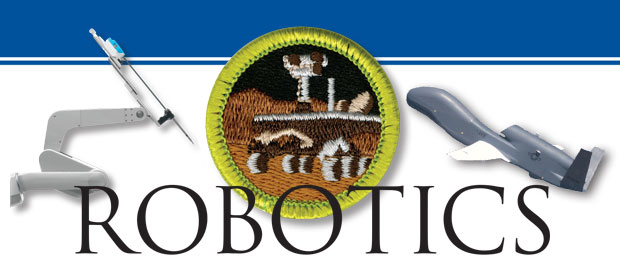Robotics merit badge

Earning the Robotics merit badge requires a Scout to understand how robots move, sense the environment, and understand what to do.
REQUIREMENTS
Visit https://www.scouting.org/merit-badges/robotics/ for the latest Robotics merit badge requirements.
RESOURCES
The Robotics merit badge pamphlet and the new interactive digital merit badge pamphlet are filled with resources to help you learn about robots. Here is a sample of what you can find in those pamphlets:
What Qualifies as a Robot for the Robotics Merit Badge?
What are “Degrees of Freedom?”
Robotics Safety and First Aid
This video can help you get started with requirement 1.
Methods Robots Use to Move
This video can help you get started with requirement 2c.
Careers in Robotics
This video can help you get started with requirement 7.
ASK AN EXPERT
Have a question about robotics? Stuck on a technical issue that you can’t figure out? Experts Tarek Shraibati, Rick Tyler, and Kenneth Berry are here.
- Should my son join a FTC or VRC after Lego?
- What does ‘2 degrees of freedom’ mean in requirement 4b?
- Is Electronics merit badge a prerequisite for Robotics?
- Do you all think that the Arduino kits would make a good match for this badge?
- Is the Lego Mindstorms NXT kit compatible with the requirements?
ROBOTICS RESOURCES
- Download a Robotics merit badge workbook
- Robotics competitions
- Robotics 101 (courtesy of National Robotics Week)
- Overview of the engineering design process (courtesy of VEX)
- Articles, books and links
Requirement #4 is very clear when it says “Design.” Building a kit that someone else designed does NOT meet this requirement. Either change the requirement or throw out references to a kit.
This was very helpful to me in getting the Robotics Merit Badge
You offer kits but require original design..can you use a kit or not..i am confuse..mother of Autistic Boy Scout.
This stuff wasn’t useful at all! It was really annoying. Why don’t you do a burn first aid and prevention robotics guide. I really need this merit badge and this so called “guide” didn’t help at all!
-From a VERY annoyed Boy Scout